2nd Lt. Fred Dees Jr.
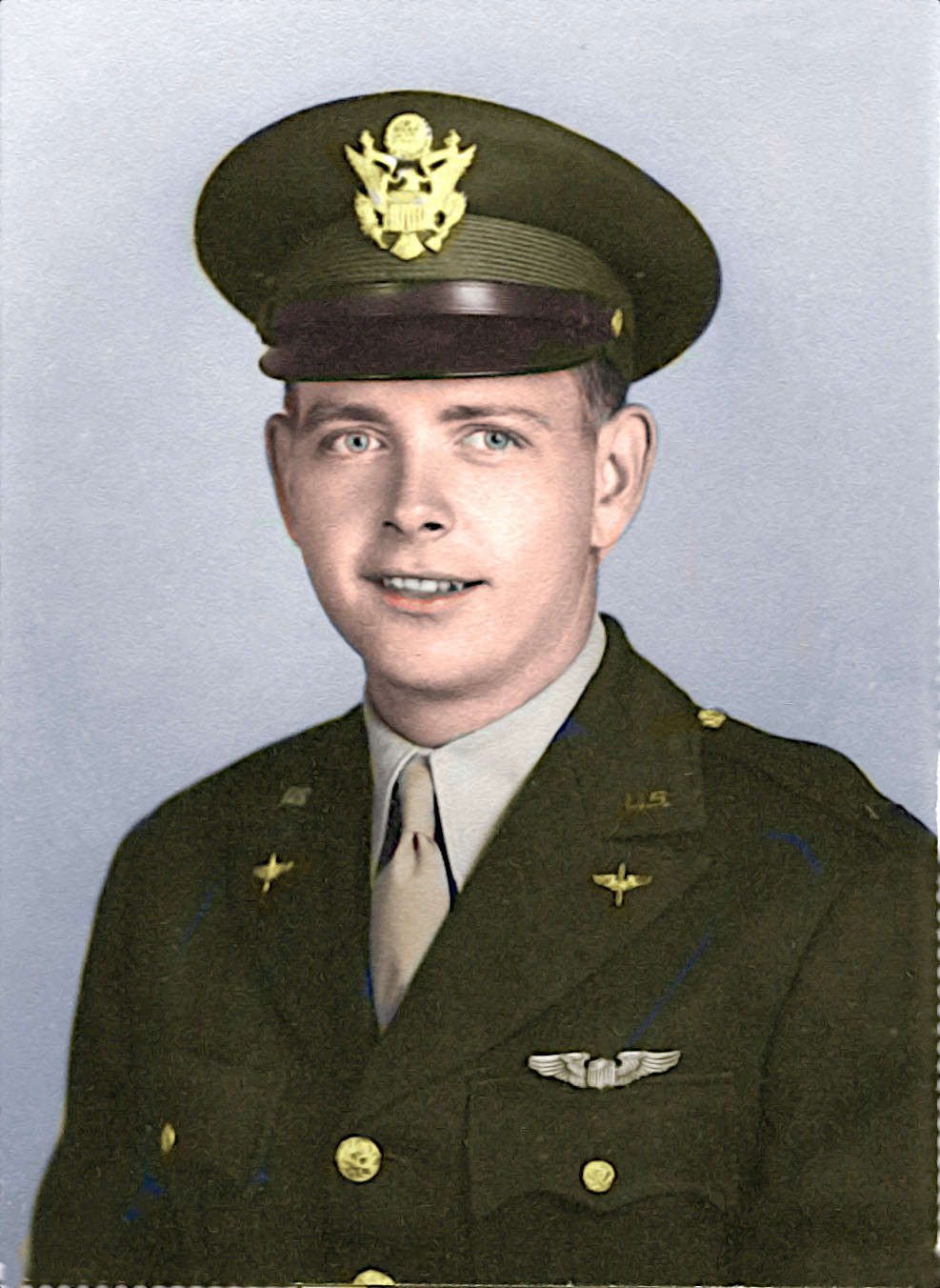
Click any image to enlarge.
Information provided by nephew Fred Dees and various news sources.
——-Some background information needs to be reviewed before learning about Freddie Dees.
Those who are familiar with the Marauders assigned to the 344th Bomb Group may have run across pictures of an aircraft named “Freddie Dees,” and wondered who it was named after. See some images below.
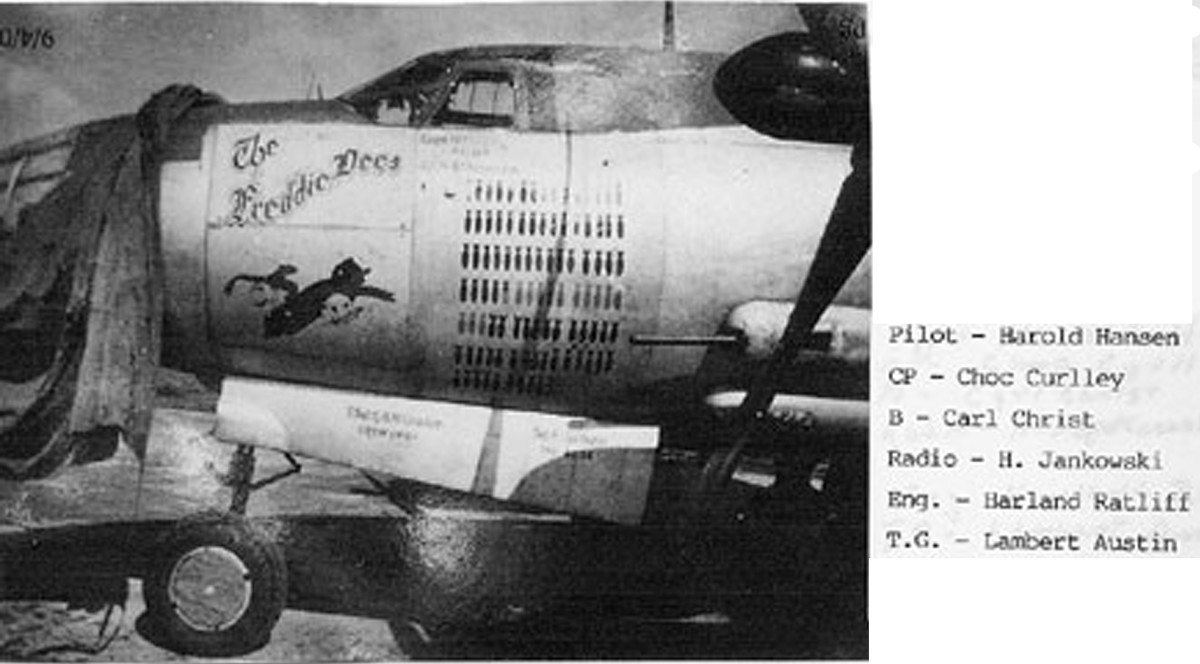
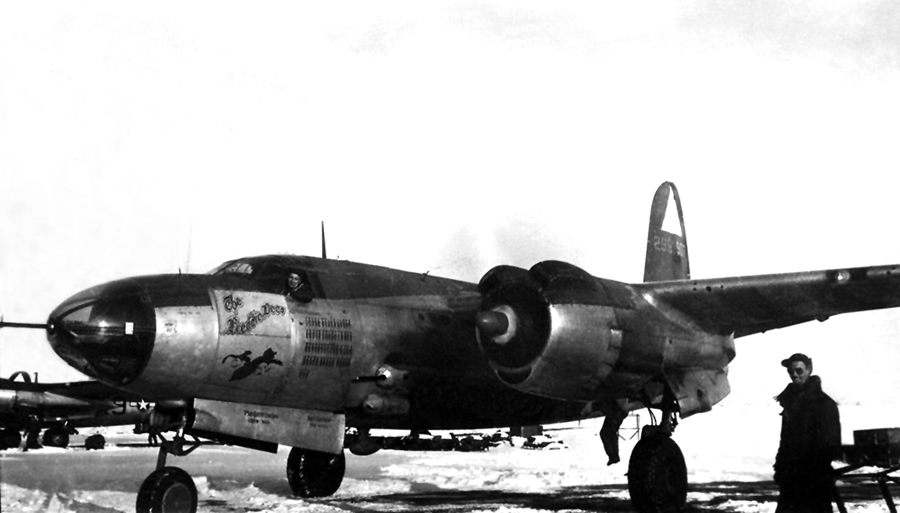
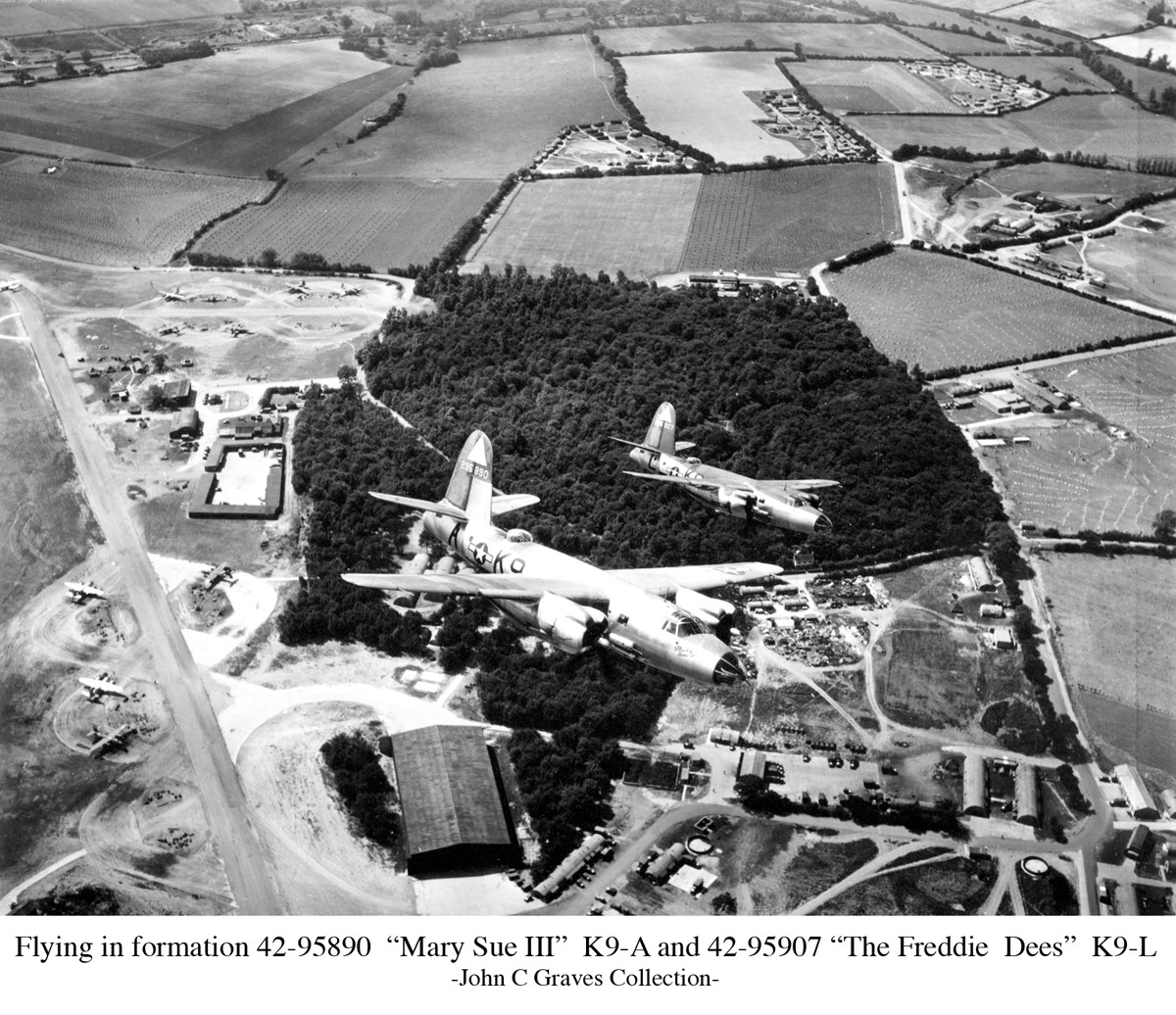
On November 25, 1940, the Martin B-26 Marauder made its first flight. A radically designed, it was a sleek, medium bomber that had powerful engines but an extremely small wing. Due to its speed, it was selected by the US Army Air Corps for tactical bombing.
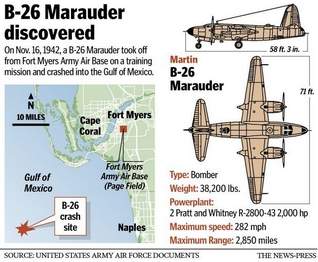
It proved to be very difficult to fly, particularly on one engine. Part of this resulted of high wing loading. The B-26 initial design offered its pilots little margin for error. The plane was safe in the hands of experienced pilots, but with the pace of pilot training, it was soon put into the hands of new trainees. What followed was a disastrous series of training crashes that nearly resulted in the cancellation of the aircraft contract and gave rise to the term, “One a day in Tampa Bay”.
With intensive twin-engine bomber transition training under way at Tampa, Florida, the US Army Air Corps was losing B-26s and flight crews at an astonishing rate. While the phrase, “One a day…” was overstated, it wasn’t by much. In the worst month, the Air Corps logged 15 crashes in just one 30 day period. The situation got so bad that the pilots took to giving the plane nicknames that highlighted their view of the plane’s deficiencies — “Martin Murderer”, “Flying Coffin”, “Widowmaker”, “B-Dash-Crash” were but a few. In addition, sexist terms were applied to the plane that included, “Flying Prostitute” and “Baltimore Whore”, both names reflecting that the plane was “so fast” and had “no visible means of support”, Baltimore being highlighted as that was where the plane was built.
With improvements in the wing design, maintenance, and pilot training, the plane would rise to become one of the most effective bombers in history.
Freddie Dees was one of the pilot trainees that lost his life will learning to fly the B-26 Marauder.
_____________________-
Letters Home
The following is the text of some letters 2nd Lt. Fred Dees sent to his mother. The last of these was written the same day he took off on his final flight!
________
Postmark Fort Myers, Fla.
November 11, 1942
480th Bomb Sq.
Page Field, Fla.
Nov. 10, 1942
Dearest Mother,
I’m using a typewriter tonight because we have no table in our barracks and the light is much better over here in the headquarters building. I have used a typewriter so seldom since I was in school that it is a real pleasure to use one again.
I suppose you wonder why you’ve missed getting a letter for the past day or two. Well, I’ll tell you the whole story: An order came thru from headquarters of the 3rd Bomber Command to select 17 co-pilots to prepare to leave for combat within the next few weeks. Well, since the order came in about the same time that my group came in, the 17 were just selected at random or drawn from a hat out of this new bunch of pilots. I was one of the ones that were drawn. Now here is the set-up. We transferred over to the 480th Bomb Sq. on Monday to be assigned to a crew. While here we will fly as co-pilots and will leave for foreign duty as co-pilots; however, that does not mean that we will be permanent co-pilots. We will probably be first pilots before the boys who are left here to check out now. I don’t know when we are leaving but I don’t suppose it will be for the next couple of weeks. Then too I am expecting to get a seven day leave next week some time. My pilot and crew are supposed to get their leaves next week or at least before we leave for combat and of course I will get one at the same time that they do. I should know something definite about that almost by the time you get this letter and if I do I will wire or call you just as soon as I know.
I’ll write again tomorrow and let you know if anything new has come up or when my leave starts. Always, sweetheart,
I love you,
Fred, Jr.
By the way, all three of us, Bell, Clanton, and I are in the same outfit and expect to be sent out about the same time. Sure do hope we can stay together.
_________
Postmark Fort Myers, Fla
November 15, 1942
Saturday
November 14, 1942
Dearest Mother,
Just time for a note to let you know that I’m alright and I still love you. I know you’ve been anxious to get some more news about my transfer, but you know no news is good news. There isn’t much to tell now except that it will probably be January before we get overseas because there is another phase of special training that we’re going go to take at Eglin Field sometime this month or next. So don’t worry about my leaving right away – that’s out, I think.
I’ve met my pilot and crew and we’re really been doing some work this week. That’s why I haven’t been able to write. Last night we flew up to Shaw Field and back. Nice trip but couldn’t see anybody because it was too late. That was a 1000 mile round trip – took us about 6 hours flying time.
I’ve got to run now and get ready for this afternoon mission. We’ve got to go out and drop 10 practice bombs. That’s really fun.
I’m going to write you a long letter tomorrow, darling. Remember to pray and keep the faith and we’ll come thru this with flying colors.
I love you,
Fred, Jr.
—————
Postmark Fort Myers, Fla
November 16, 1942
Sunday
Nov. 15, 1942
Dearest Mother,
I know you must wonder just what is going on and how my new set up is. Well, here’s how it is.
My pilot is Lt. Vail from Illinois. The crew is composed of six men – pilot, co-pilot, navigator, radio man, engineer, and tail gunner. The navigator, Lt. Mikes, is also the bombardier and fires the nose guns. The radio man and engineer fire the turret guns and waist guns. So you see the crew is made up of three officers and three enlisted men. More can be carried, tho, and probably will be if we go to combat because the ship we fly there will have many more guns. I wish I could tell you just how many guns the new B-26 carries and it’s bomb load but you can be sure it’s plenty of both.
We’ve been flying practice bombing and gunnery missions for the past week and I really like it. Friday night we took a navigation trip up to Shaw Field – I think I told you that. Well, we’re going up there again tonight. If we get in there early enough tonight I’m going to call you up. I sure do want to talk to you.
I think we’re going to Eglin Field on the 20th of November for two-three weeks. We’ll have our own ship then. We’re getting a brand new ship – the very latest thing – I can hardly wait to see it. I think we’ll come back here after we get thru at Eglin for a few weeks to wait for our call. Somehow, Mother I’m kind of looking forward to it – I’ll really have a lot to tell you when I get back.
I’ve got to go get supper now and get ready for the flight tonight. Hope I get to talk to you. When we get our new ship, Maybe I’ll be able to take a trip near enough to home for you to see it and meet the crew.
I’ll try to write again tomorrow and tell you all about our trip tonight.
I love you,
Fred, Jr.
At 6:10 p.m., Nov. 16, 1942, his aircraft took off on a training mission from the Fort Myers Army Air Base, now known as Page Field.
Fifty minutes later, the airbase got a radio call from the plane that the crew was bailing out. Then silence.
Two days later, search teams found the bodies of pilot Lt. Donald Vail and and co-pilot Lt. Fred Dees (the report states that Dees’ watch was stopped at 1905, or 7:05 p.m.). The bodies of the other four crew members were never found.
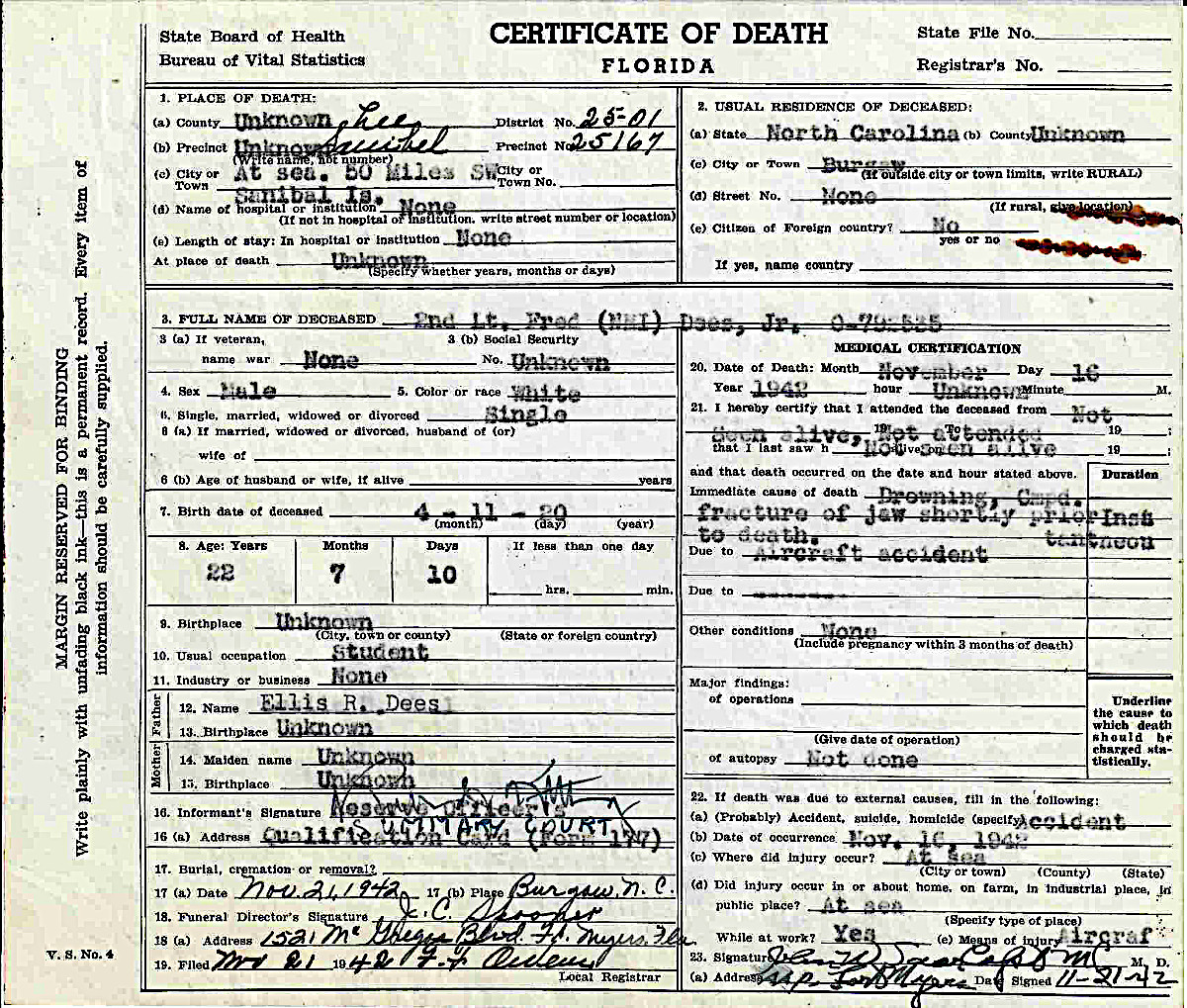
_____________________
Lt. Fred Dees, Jr. – Co-Pilot
Burgaw, North Carolina
April 11, 1920 – November 16, 1942
Fred Dees, Jr. was born in the town of Burgaw, North Carolina on April 11, 1920. Dees father, Fred Dees, Sr., was a pharmacist and his mother, Ellis, took care of Fred and his two brothers.
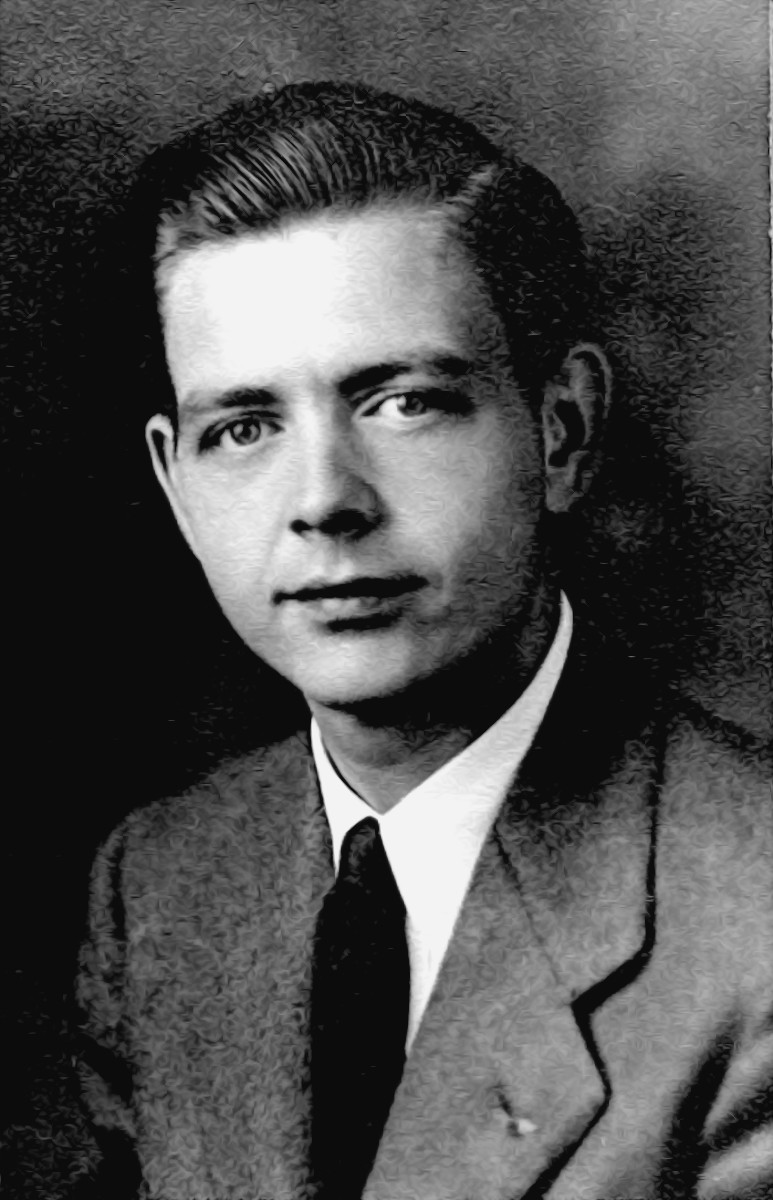
Fred lived a charmed childhood. He was the All-American boy, voted class president, and had the lead in the senior play. Fred Jr. studied pharmacology at the University of North Carolinian Chapel Hill.
In January of 1942 with graduation pending, Fred registered for the draft. In a class paper he wrote,”I am in medicine, but I intend to be a warrior.”
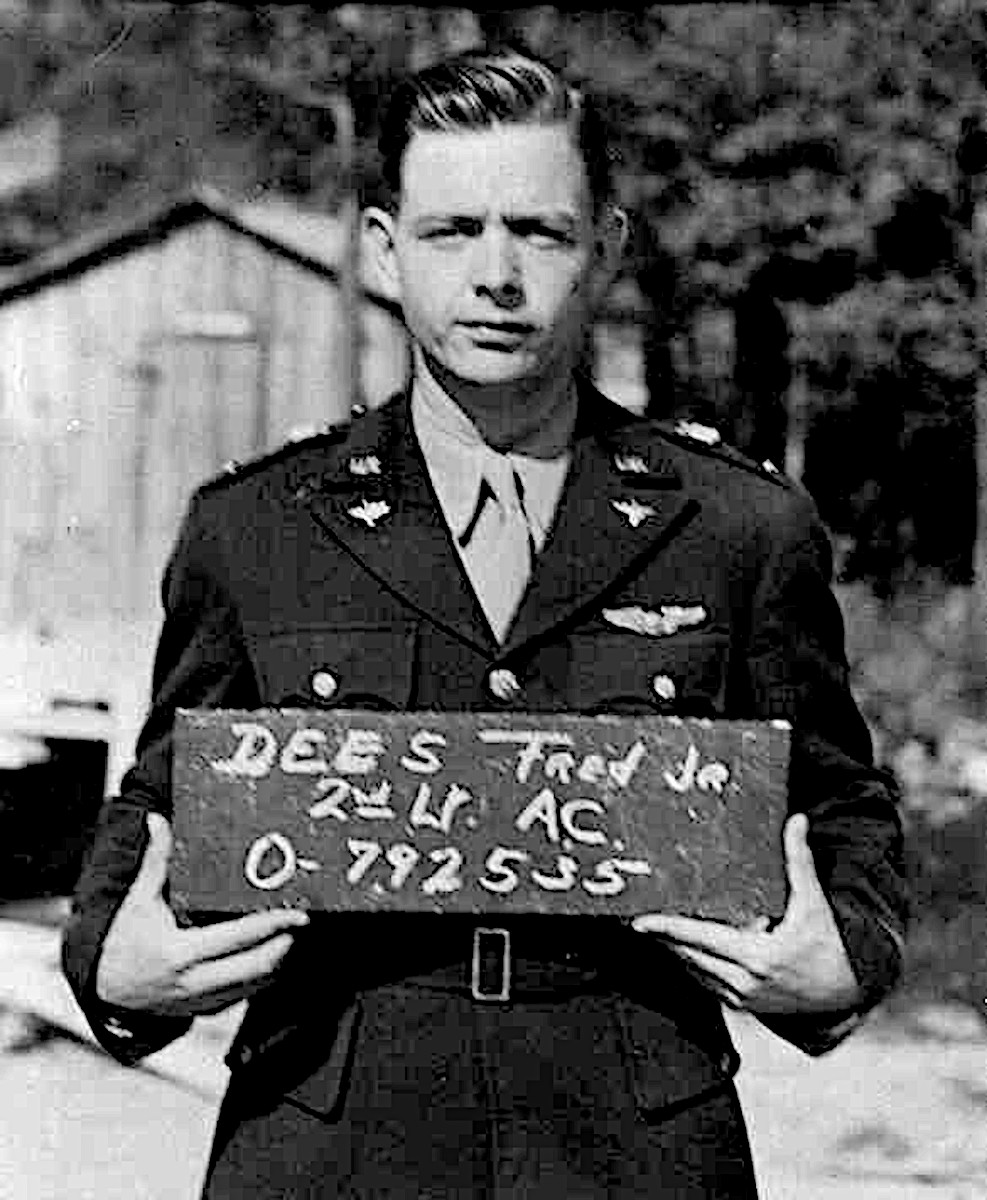
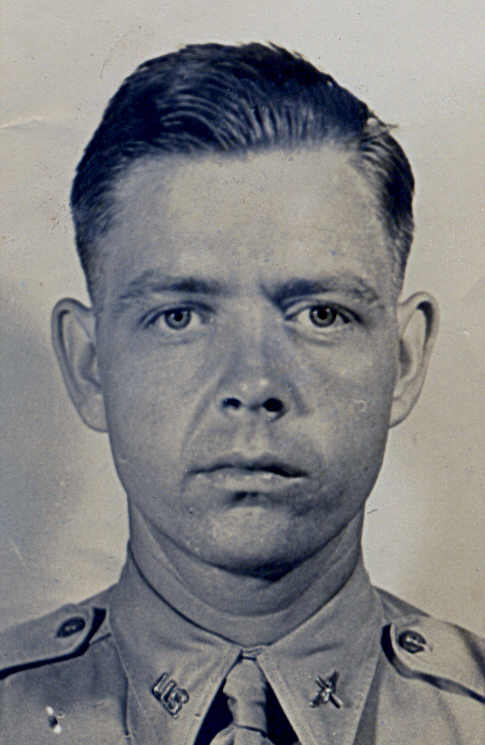
Lt. Dees trained to become a pilot at airfields in Florida, South Carolina,
Alabama, Georgia, eventually ending up at Page Field in Fort Myers. Fred wrote to his mother almost every day, the last correspondence dated November 14, 1942, just two days before the fatal accident:
For Lt. Dees’ funeral, a 20-piece band arrived from Camp Davis located near the famous Marine base at Camp Lejeune. At least 100 neighbors were on hand to walk with the flag-covered casket to the cemetery. Lt. Dees is buried next to his mother Ellis, who died in1995.
Investigation of 1942 Crash off B-26 Marauder off Sanibel Island Begins in Earnest
By Kevin Lollar
news-press.com
The story originally appeared in The News-Press, Oct. 31, 2008
POLK CITY – For 66 years after a B-26 Marauder went down in the Gulf of Mexico 30 miles off Lee County, the cause of the crash has been officially listed as unknown.
But recent evidence from the aircraft itself and memories of World War II airmen are leading to a revision of the record.
This week, a team investigating the crash met with members of the B-26 Marauder Historical Society at the Fantasy of Flight aviation museum, hoping to gather clues.
A crash in the Gulf
At 6:10 p.m., Nov. 16, 1942, a B-26 took off from Fort Myers Army Air Base, now known as Page Field. Pilot Lt. Donald Vail of Macomb, Ill., had 144 hours’ flight time in B-26s; the aircraft had flown 95.6 hours.
Fifty-five minutes later, the air base received a radio call from the B-26 saying the six-man crew were bailing out.
Search teams found the bodies of Vail and co-pilot Lt. Fred Dees of Pender County, N.C., on Nov. 20. Neither the rest of the crew nor, for many years, the plane, were found.
“It was night; there was 3,500-foot overcast; they were 30 miles out,” Delta Air Lines pilot Kevin McGregor, an aircraft crash specialist, told the historical society. “It was a brand-new plane with a brand-new pilot. Something happened to make the pilot order a bail-out.”
Finding the plane
In 1990, fishing guide Tim Wicburg discovered wreckage of a B-26 in the Gulf and thought it was a plane that had crashed after smuggling billions of dollars out of Cuba the day Fidel Castro took power.
Along with Tom O’Brien of Chicago, commercial diving consultant Capt. Jon “Hammerhead” Hazelbaker, and fabricator Brian Ulman, Wicburg formed TBT&J Adventure Vacations and set out in May to find the Cuban treasure.
Instead of gold, TBT&J divers found the aircraft’s serial number, which identified it as a B-26 that crashed Nov. 16, 1942.
TBT&J obtained the official accident report, on which was typed, “Pilot charged with accident,” which the team took to mean that the Army Air Forces blamed Vail for the crash.
The B-26 was an early model of the Marauder and notorious for crashing from mechanical failure, so the team decided to investigate and possibly exonerate the pilot – they found out later that the official cause of the crash was unknown.
Gathering evidence
Pat Clyne of Paradigm Productions in Key West shot video of the wreckage in May and sent it to McGregor, who was intrigued by what he saw.
On Sept. 17, McGregor, Clyne and TBT&J members dove the wreck site.
Debris was scattered over a quarter mile;
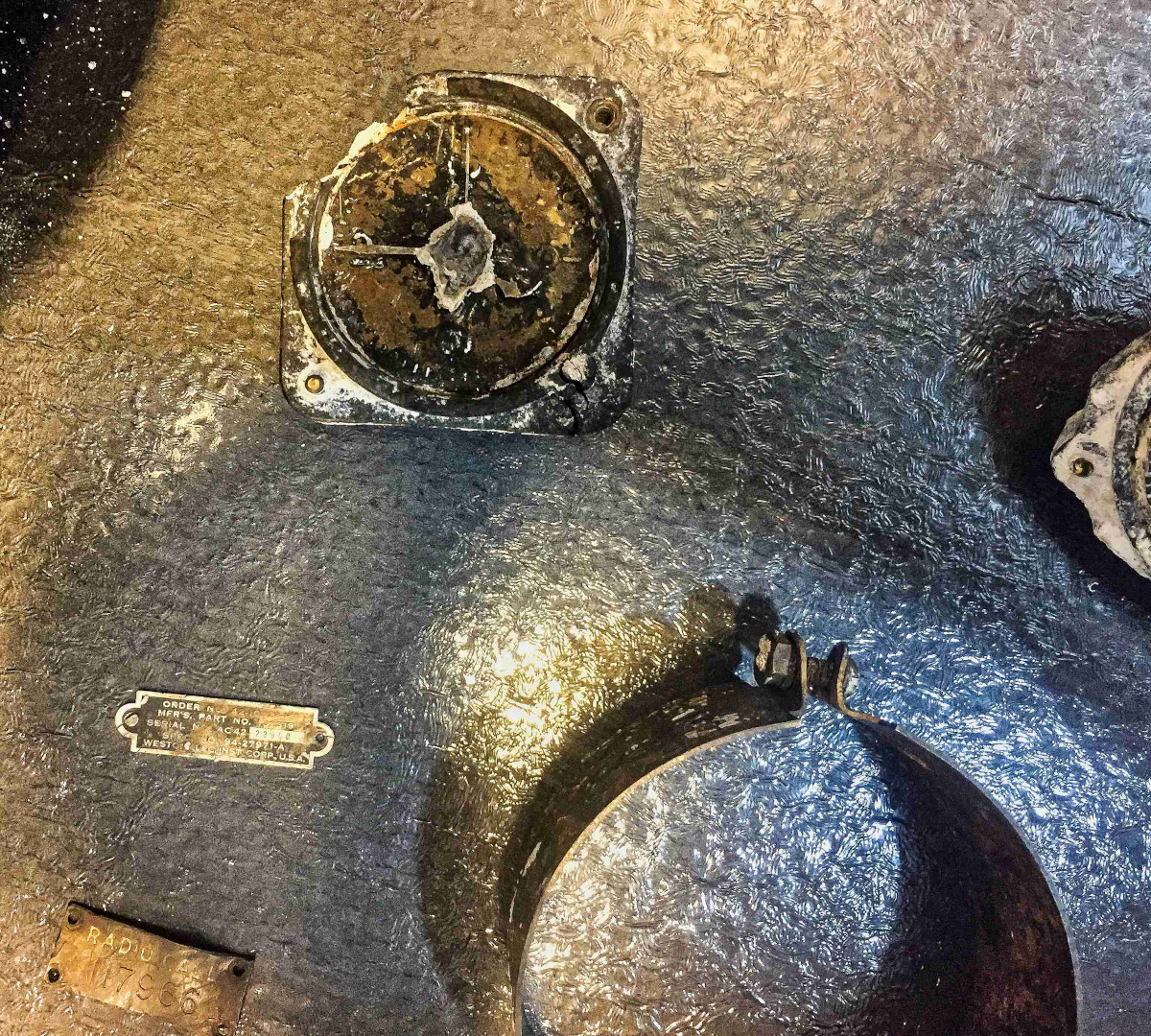
The right wing was badly damaged (the left wing was not); the right propeller was not attached to the engine (left propeller and engine were intact). This all indicated that the plane crashed at a shallow angle, at high speed, with the right wing hitting the water first.
McGregor figured the key to the crash was the right propeller, so the divers raised it and sent it to propeller expert Paul Gaither in Opa-Locka.
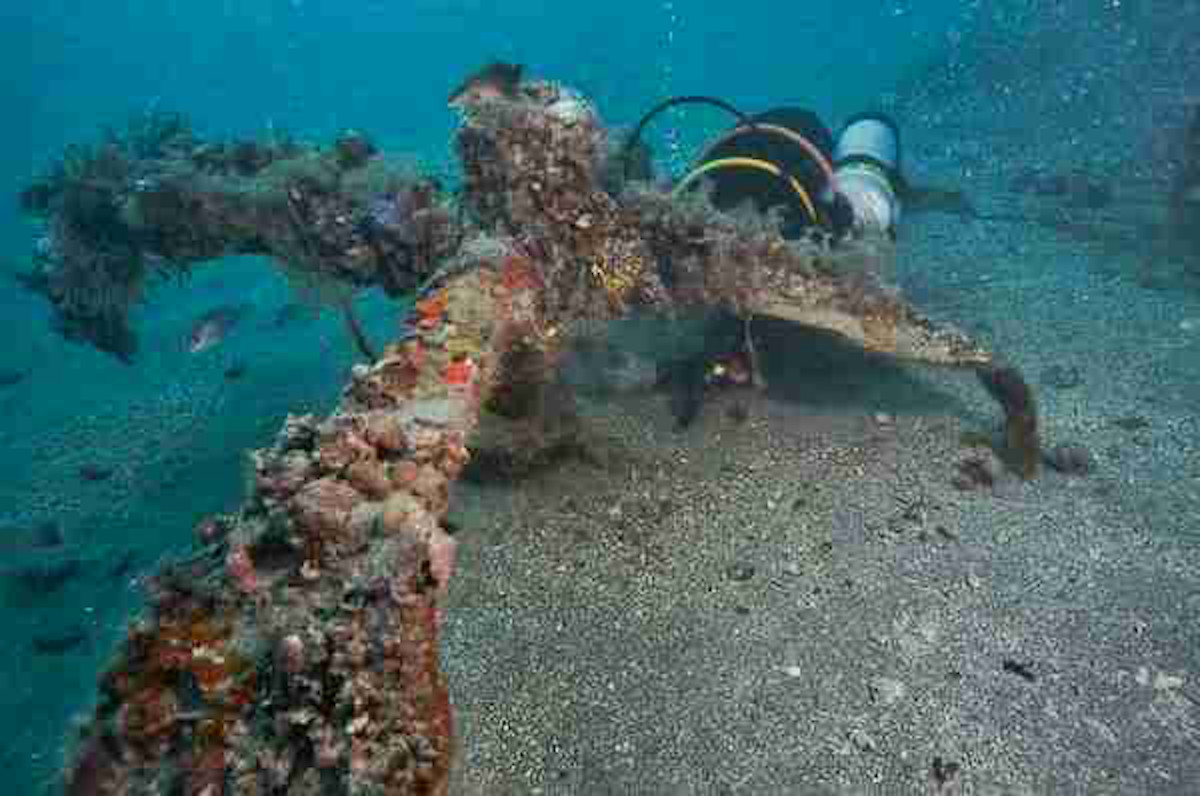
Flat pitch
Marauders used variable-pitch Curtis props; the pilot can change the angle, or pitch, of the blades relative to the airflow. Sometimes, though, the props changed angle on their own, resulting in flat pitch with the blades facing flat into the airflow.
Gaither determined that the pitch on the Marauder’s right prop was flat.
“Somehow, they lost control of the pitch in flight,” McGregor said. “If you can’t get out of a flat pitch, you lose control of the aircraft. It’s like putting out a drogue chute. I don’t think a plane is flyable with a flat pitch.”
Marauder veterans said that Curtis props tended to malfunction on takeoff rather than in flight, but Edmond Clemenzi, 91, who flew 72 missions as a B-26 bombardier, said the pitch probably changed in flight when a ground wire from the prop to the motor that controls pitch vibrated loose.
“That happened once when we were flying out of Lakeland over the Gulf in 1942, “Clemenzi said. “The pilot said to bail out, and I said, ‘B.S.’ There was a switch that overrode the automatic switch, and that fixed it. The pilots should have known it, but they didn’t because they didn’t have the training hours.”
McGregor said the loose-wire theory was a possibility.
Gaither made a second discovery. Large pieces were missing from the inside of three of the right prop’s four blades: The blades had crashed into the engine cowling, either while the plane was still in flight or as it hit the water. Hazelbaker believed that the prop moved backward while the plane was in the air, causing the blades to slam repeatedly into the engine.
Next steps
TBT&J is now forming a non-profit organization called Underwater Historical Explorations to raise money for future projects and to finance the completion of a documentary on the B-26 Marauder.
Clyne, who worked for treasure hunter Mel Fisher for more than 30 years, has shot 18 hours of video and will soon begin post-production.
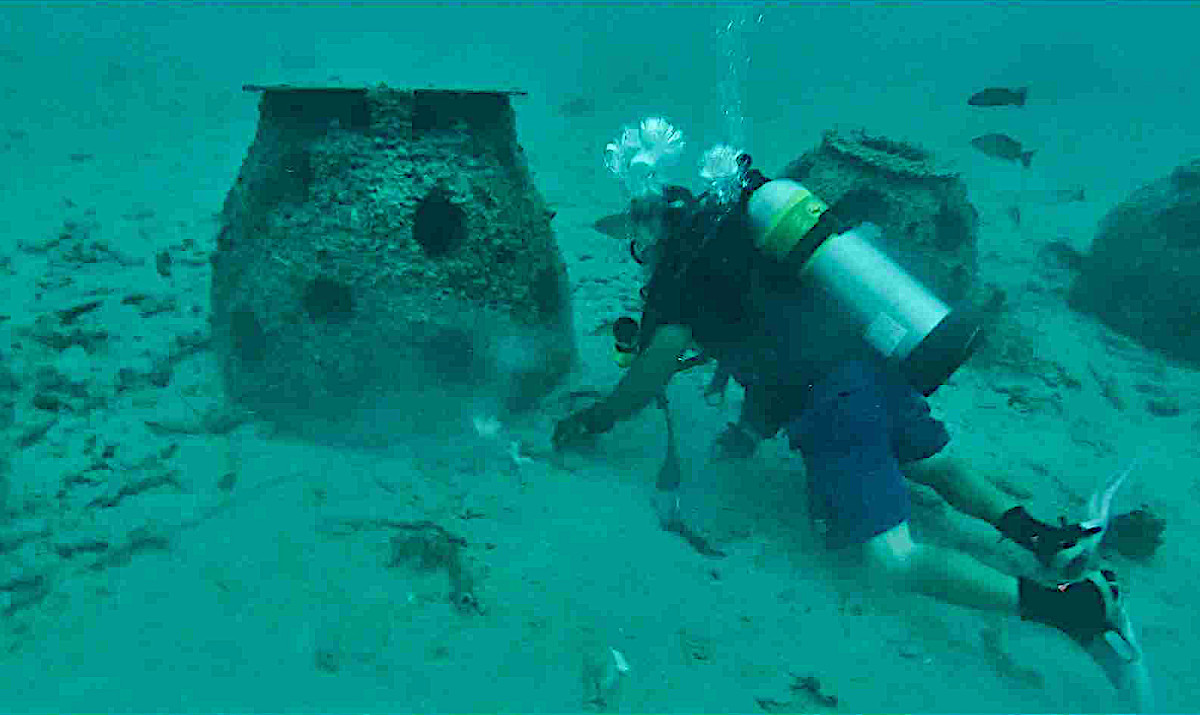
http://shopwornangel.imaginarynumber.net/wp-content/uploads/2017/11/Freddie-Dees.jpg


